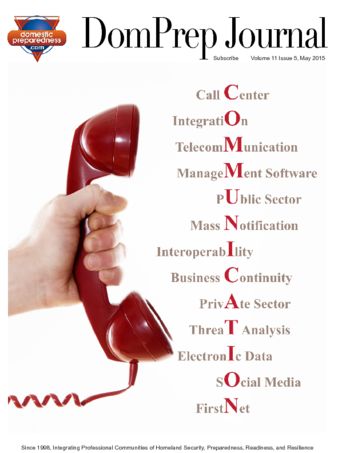
How to Deploy an Ethical Cybercommunications Program
Anyck Turgeon
May 27, 2015
Cybercommunications 101: How to deploy an effective cybercommunications program as part of an emergency, disaster recovery, and business continuity effort. As more common, daily-use devices become automated, the risk of cybersabbotage and cyberattacks increases, so planners must take measures to prevent harm to their efforts, personnel, agencies, and organizations.

Football, Golf & an Integrated Public Safety Information Network
Janusz Wasiolek
May 27, 2015
Managing one large-scale special event can be a public safety challenge for any jurisdiction. However, when multiple events and hundreds of thousands of people converge in one area, communications between public safety officials is critical. Using the Homeland Security Information Network, officials in the greater Phoenix area kept the lines of communication open.

Bridging the Public-Private Sector Divide
Catherine L. Feinman
May 27, 2015
At the April 2015 Ready Chesapeake meeting, members of this nonprofit group discussed ways to build business continuity within Annapolis-area communities and created a survey to reach out to other jurisdictions for suggestions. Practitioners (149 public sector, 80 private sector) from 47 U.S. states, Washington, D.C., Canada, and Martinique shared their insights from both the public and private sector perspectives.

InfraGard - Over 400 Sector Chiefs in 84 Chapters
Sheri Donahue
May 20, 2015
After receiving credible information about an al-Qaida threat to high-profile buildings where financial institutions were located, the U.S. Department of Homeland Security shared that information through the InfraGard network. InfraGard then used the Sector Chief Program to rapidly disseminate the necessary details to the right people within those institutions.

Defining & Working With 21st Century Mass Media
Anthony S. Mangeri
May 19, 2015
Mass media can be allies or adversaries to emergency management agencies. The key for these agencies is to ensure that media outlets are sharing accurate public safety and incident-related information from trusted and reliable sources. This means that emergency managers must understand news media objectives and develop mutually beneficial working relationships.

CNA Out Front: Engaging Communities of Color in Positive Policing
Domestic Preparedness
May 17, 2015
In an executive discussion session, CNA Corporation addressed the movement toward evidence-based policing. When providing resources to the concentrated geographic areas that experience the highest levels of violent crime, law

Draft Report: National Space Weather Strategy
Domestic Preparedness
May 15, 2015
The National Science and Technology Council’s Committee on Environment, Natural Resources, and Sustainability requests public comments on the draft 2015 National Space Weather Strategy for its Subcommittee on Disaster Reduction. Submit comments by 29

What the Future Holds for Communications Interoperability
Steve Cohan
May 13, 2015
The terrorist attacks of 9/11 put a spotlight on the gaps that existed and, in many jurisdictions, still exist between public safety agencies. Although most preparedness professionals would agree that it is critical to have interoperable communications, there are factors that hinder achievement of this goal. With careful consideration, agencies can overcome these hurdles.

Gyrocopters & Other Rapidly Developing Threats
Rodrigo (Roddy) Moscoso
May 12, 2015
On 15 April 2015, a 61-year-old mailman from Florida breached restricted airspace over the nation’s capital and landed a gyrocopter on the West lawn of the U.S. Capitol building. Although this event did not involve explosives or other hazardous materials, the next incident may not be benign. Communication gaps must be closed.

Public-Safety Broadband Network: FirstNet Should Strengthen Internal Controls and Evaluate Lessons Learned
Domestic Preparedness
May 9, 2015
This report by the Government Accountability Office details (a) FirstNet’s progress carrying out its responsibilities and establishing internal controls; (b) the estimated network cost and FirstNet’s plans to become self-funding;






